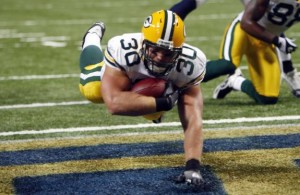In May, I discussed how and why the fullback was being slowly phased out of the game. Some of the main reasons are:
- The increase in the size of defensive linemen has made running up the middle less attractive.
- The blocking fullback has been replaced by the slot receiver: A great blocking fullback will take a linebacker out of the play, but an average slot receiver will take a linebacker off the field.
- Tight ends are now among the most athletic players in the game, and the fullback is essentially a shorter, slower, tight end. Teams aren’t looking to leave a multi-dimensional tight end or a slot receiver off the field for a six-foot lead blocker.
- The pass-catching fullback is the option of last resort for an offense, not an element of design. No offensive coordinator is spending his time thinking about how he can get the ball into the hands of his fullback more often.
- Fullbacks are being diverted into other career paths: a fast high school fullback becomes a running back, a tall fullback becomes a tight end, and a strong fullback puts on weight to become a linebacker.
But enough about theory: let’s analyze how teams are using fullbacks in today’s NFL, courtesy of Pro Football Focus. Let’s break the teams down into tiers:
Fullbacks need not apply: Arizona, Philadelphia, Denver, Dallas, Detroit, Cincinnati, and Miami
The Cardinals and Eagles have not had a fullback on the field this season. Philadelphia runs a lot of three-wide receivers sets with DeSean Jackson, Riley Cooper, and Jason Avant, and LeSean McCoy and/or Bryce Brown are always on the field. Add tight ends Brent Celek and Zach Ertz see significant playing time, too. You could classify James Casey as a fullback (PFF labels him a tight end), but he has just 60 snaps this year. For Arizona, tight ends Jim Dray, Rob Housler, Kory Sperry, Jake Ballard, and even D.C. Jefferson get on the field in lieu of any fullbacks. Head coach Bruce Arians does not see much of a need for a fullback, as Robert Hughes had just 28 snaps in Indianapolis last year.
Dallas, Denver, and Detroit all use 3-WR/1-TE as their base personnel, and little changes even when those teams are leading. Dallas will put TEs James Hanna and Gavin Escobar on the field with Jason Witten in run-heavy sets, and backup linebacker Kyle Bosworth is responsible for all 9 snaps taking by a Cowboys fullback this year. Wes Welker and Julius Thomas are textbook examples of why the fullback is becoming extinct. Welker’s prowess as a slot receiver far exceeds the value any fullback could add, while Thomas is the type of athletic superfreak teams are finding to play at tight end. Virgil Green, Joel Dreessen, and Jacob Tamme see time when the Broncos want to run, and defensive tackle Mitch Unrein (8 snaps) is the only fullback Denver has used. For the Lions, Joseph Fauria (and, prior to his release, Tony Scheffler) is used when the Lions want more blockers on the field, and the team will occasionally put Reggie Bush and Joique Bell on the field together, too, leaving just two snaps this season for fullback Montell Owens.


